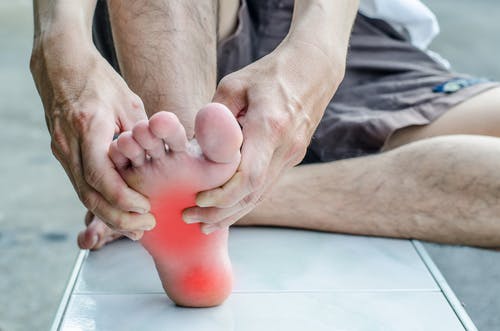Plantar Fasciitis

Plantar Fasciitis is the most common heel pain condition we see at Foot Right Podiatry. The Plantar Fascia is a thick and fibrous band of tissue that starts at the base of the heel bone (calcaneus) and ends at the ball of your foot (metatarsals). The primary role of the plantar fascia is to support the arch of your foot and can easily be injured when overloaded or overused.
People will present with plantar fasciitis at different stages of severity. Initially, you may feel as though you have a bruised heel, which stops you from doing all the activities you wish to or prevents you from wearing certain shoes. At Foot Right Podiatry, we find that most of our clients will ignore the problem at this stage, and hope that the pain will just go away.
As the condition progresses, you may feel that the heel area has become more uncomfortable. The area of discomfort can move from your heel to further into your arch. The pain will be apparent strongly when you first get out of bed in the morning, and can cause you to hobble for your first steps before the pain reduces or goes away completely.
At its most severe, plantar fasciitis will cause moderate to intense pain on the undersurface of your heel and arch throughout the day with very little relief. You will want to change your footwear regularly and will be always searching for a more comfortable shoe.
In some cases, you may have a tear or even a rupture of your plantar fascia. This is a serious condition and can require surgical intervention.
COMMON CAUSES OF PLANTAR FASCIITIS
• Non-supportive footwear
• Tight calf muscles
• Foot structure – high arches as well as flat feet can contribute to heel pain
• Sudden increase in activity levels – often associated with a get fit program!
• Increase in body weight
At Foot Right Podiatry we use the latest evidenced based techniques to treat plantar fasciitis. We initially conduct a biomechanical assessment so we have a good understanding of the reason why your plantar fascia has become overloaded. In some cases, we may recommend further examination like X-Ray or Ultrasound to check your bone structure and the health of your plantar fascia, but this is not always required.
Initial treatment often involves strapping, strengthening exercises, FS6 socks (compression socks), footwear assessment and dry needling. If you have other underlying biomechanical problems, we may recommend orthoses to address the faulty mechanics of your foot, but this is not generally our first line of treatment.
If you believe you are suffering from plantar fasciitis, call us or book now to get relief!